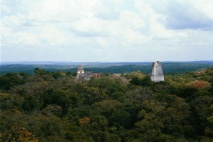The Tour
After a brief stop at Tikal Inn, to leave our luggage behind, we followed our guide into the national park. Pausing to admire the ceiba tree, which our guide instructed was of religious significance to the Mayas, we learned that this particular tree represents the various worlds in which the Mayas believed. The roots of the ceiba tree signify nine levels of the underworld; the trunk depicts the world we currently live in; and the branches are indicative of the thirteen levels of heaven.
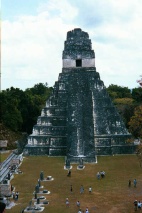
As we proceeded toward the Great Plaza, which consists of Temples I and II and the North and South Acropolises, our guide gave us a historical overview of the area. On the way to the plaza, he kept up a friendly chatter outlining the details on the Maya religion, and the astronomical achievements of this ancient society.
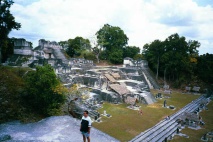
After an all too brief period spent climbing Temple II and the North Acropolis, and using up lots of our film in the Great Plaza, we continued walking toward Temple III, then branched off in the direction of El Mundo Perdido, the Lost World. El Mundo Perdido appears to have been Tikal's center for astronomical study.
Temple IV is only partially excavated, but some of us chose to climb the ladders to the top anyway, perhaps motivated by our guide, who told us our lunch tickets were up there. Of course, this was the same guy who told us we were having monkey brains for lunch...go figure. On the other hand, the absolutely fabulous view from the top of Temple IV was more than enough motivation for me.
Mayan Astronomy
The Mayans' knowledge of astronomy was very advanced. They used an elaborate calendar system, combining 2 calendars, one of 13 months and the other of 18 months; months were made up of 20 days. The starting point of the present Great Cycle was August 13, 3114 BCE. The "Vague Year," of 18 months, actually had 365 days - the last 5 days were added at the end and considered unlucky. Every 52 years, the calendars coincide on a day called 4 Ahau 8 Cumku. The next time they coincide, which will be at the end of the current Great Cycle, is Dec 23, 2012, which is prophesied by the Mayan culture to be the end of the world (alternately, it has been interpreted as a major shift rather than the end of civilization).
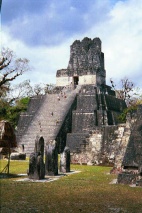
The importance of the number 52 can be seen in several of the temples. Temple II has 49 steps and 3 distinct levels (do the math). >From Temple I, you can see the roofcomb on Temple 4. Every 52 years, through the north holes on the roofcomb, Venus and Jupiter are visible. After 26 years, they can be seen through the south holes. Other roofcombs can be used to track different astronomical movements from various spots in Tikal.
Mayan Religion
What little is known of the Mayan religion comes from the detailed hieroglyphics found in various Mayan sites, and the Popol Vuh, an ancient Mayan text translated during the Conquest.
It was originally thought that Mayans were a peaceful people, but further discoveries lead archeologists to believe that they practiced extensive sacrifices, both animal and human, including personal sacrifices which involved piercing themselves and offering their blood to the gods. Nobles and priests are often portrayed in this manner on carvings on the temples and other buildings. Carvings on the altars and at the stelas, (which are carved standing stones, by the altars) usually portray nobles conducting sacrifices.
There are, as in other belief systems, colours assigned to the cardinal directions: red is the East, thought to represent the sunrise; black or blue, the West, for darkness; white to the North represents the nobility; and to the South, yellow represents the lower classes. The Center is represented by green.
The Decline of Tikal
There are several theories about the downfall of Tikal as a cultural, religious and trade center in the Mayan world. Some have suggested that a plague or natural disaster may have struck, but there is no supporting evidence of this. The strongest theory takes into account several factors:
- Over-population: at its largest, Tikal is thought to have had a population of 90,000 people
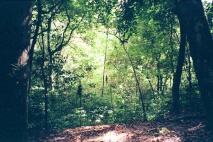
- Deforestation: the area surrounding the city center was used to grow crops. In order for corn, the staple food of the Mayas, and other basic foods to grow, one square mile can only be used for two years. The land must then be left barren for six years to recover its fertility. Such a large population would have exhausted the easily accessible land quite rapidly.
- Internal wars: As the food and water supplies dwindled, the lower class may have revolted against the priest class, which was supposed to intervene with the gods on their behalf. The lack of food and water was evidence that the priests were failing at their duties.
- External wars: There were certainly skirmishes with other Mayan sites, moving from a period of cooperation with them to a period of conflict. This would have reduced supplies of various sorts that were coming to Tikal through trade with these other areas.
- Self-sacrifice: The priest class may have foreseen the decline of Tikal in the other factors that were present. Evidence shows that there was an increase in the number of sacrifices of priests, who believed they would achieve immortality by offering themselves. This sudden loss of a large portion of the educated elite would have aided the decline.
Whatever the reason, Tikal's importance faded from 700 to 900 CE, during what is known as the Post-Classic period. By 900 CE, only 20 percent of the population remained, and these subsequently left the area, relocating mainly to Chichen Itza, in the Yucatan peninsula. The ruins at Tikal were not re-discovered until an official expedition was launched in 1948. Fifty years later, Tikal has become a major tourist attraction, which helps fund further excavations. I strongly encourage everybody to visit this site, but please remember the phrase "Take nothing but photographs; leave nothing but footprints."
References
- Coe, William R. Tikal: A handbook of the ancient Maya ruins. University of Pennsylvania, Philadelphia, 1967.
- Morley, Sylvanus G. and Brainerd, George W. The ancient Maya. Stanford University Press, Stanford, 1946.
- Coe, Michael D. The Maya. Thames and Hudson Inc., New York, 1993.
The text and pictures on this page are copyright to myself. I went to a lot of work researching this, and sweated buckets to get the photos. Please do not use them without my permission. Thanks!
